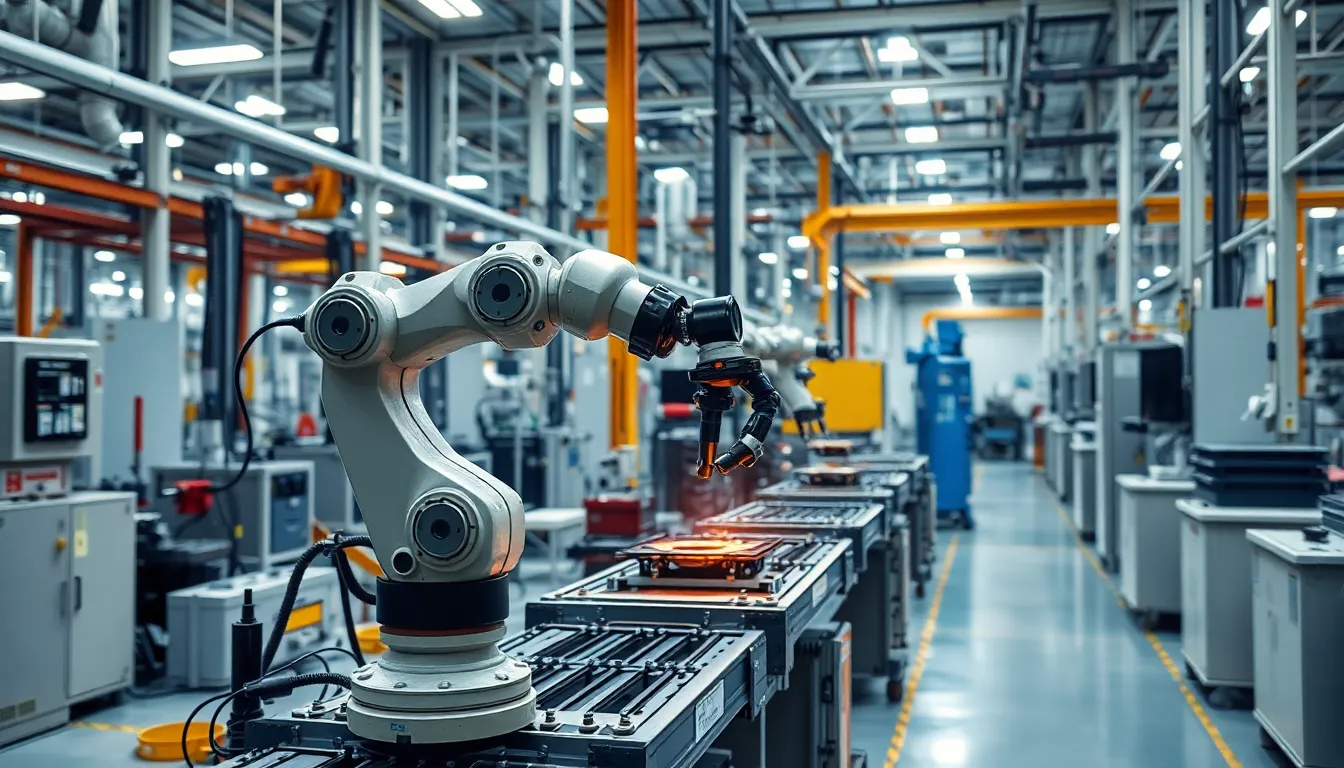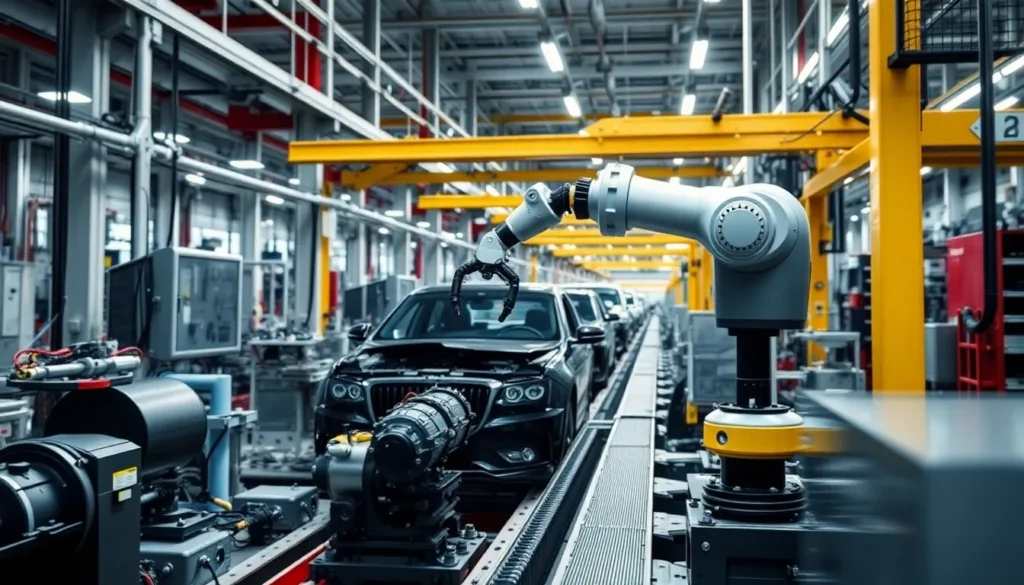Table of Contents
ToggleRobotics isn’t just for sci-fi movies anymore; it’s a booming field transforming our everyday lives. From the friendly vacuum that gobbles up dust bunnies to industrial robots assembling cars faster than you can say “robot uprising,” these machines are changing the game. They’re not just taking over mundane chores; they’re revolutionizing industries and even saving lives.
Overview of Applications of Robotics
Robotics serves various sectors, dramatically changing how tasks are performed. Within manufacturing, robots enhance production efficiency, ensuring precision and speed. Autonomous robots streamline processes in automotive assembly lines, reducing labor costs and human error.
In the healthcare field, surgical robots assist with delicate procedures, improving outcomes and minimizing recovery times. These advanced systems enable surgeons to perform intricate operations with greater accuracy, leading to fewer complications. Additionally, rehabilitation robots support patients regaining mobility, providing tailored exercises customized to individual needs.
Household applications of robotics encompass automated vacuums and lawnmowers, making daily chores less labor-intensive. These devices utilize sensors and programming to navigate spaces effectively, allowing users to focus on other tasks.
Service robots find utility in hospitality and customer service roles. Many hotels deploy robots to deliver items or provide information, enhancing guest experiences. Similarly, retail stores use robots for inventory management, optimizing stock levels and ensuring product availability.
Agricultural robots play a pivotal role in enhancing food production efficiency. Drones monitor crop health, while automated harvesting systems reduce labor requirements. Precision agriculture techniques rely heavily on robotics to maximize yield while minimizing resource costs.
Exploration and research benefit immensely from robotics in challenging environments. Underwater drones gather data from oceans, and planetary rovers conduct analyses on Mars. These robotic explorers expand human knowledge in ways that were previously unattainable.
Applications of robotics continue to expand across various industries, showcasing their versatility and transformative potential. Their integration into daily life offers significant advantages, thus shaping the future landscape of numerous fields.
Industrial Applications

Robotics significantly improves industrial processes, driving efficiency and precision across various sectors.
Manufacturing Automation
Manufacturing automation utilizes robotics to streamline production processes. Assembly lines now integrate robotic arms, which perform repetitive tasks efficiently. These machines reduce human error, leading to consistent product quality. Automotive plants, for instance, employ robots for tasks like welding and painting, increasing throughput. The combination of speed and accuracy enhances overall productivity, allowing businesses to meet consumer demand effectively. Companies often report reduced labor costs and shorter production times as a direct result of these automated systems.
Quality Control and Inspection
Quality control benefits greatly from robotics, ensuring products meet stringent standards. Automated inspection systems employ advanced sensors and cameras to detect defects quickly. These systems provide real-time feedback, allowing manufacturers to adjust processes immediately. Robots assess quality at various stages of production, minimizing the risk of defective products reaching consumers. Statistical process control utilized by robots helps in maintaining consistent quality levels. Companies that implement robotic inspection report lower return rates and higher customer satisfaction.
Healthcare Applications
Robotics significantly enhances healthcare, providing innovative solutions that improve patient outcomes and streamline processes.
Robotics in Surgery
Surgical robots enable surgeons to perform intricate procedures with enhanced precision. They offer high-definition 3D visualization, which aids in navigating complex anatomical structures. During surgeries, robotic systems like the da Vinci Surgical System allow for minimally invasive techniques, leading to reduced recovery times and less postoperative pain for patients. Many hospitals now incorporate robotic-assisted surgeries in urology, gynecology, and cardiology. Such advancements not only improve surgical accuracy but also lower the risk of complications associated with traditional methods.
Rehabilitation Robotics
Rehabilitation robots play a vital role in helping patients regain mobility after injuries or surgeries. These devices assist individuals by providing guided support and targeted exercises. For instance, exoskeletons help stroke survivors rebuild strength and coordination. It’s common for facilities to use robotic systems that track progress and adjust therapies based on individual patient needs. The integration of robotics in rehabilitation not only enhances recovery rates but also promotes patient engagement through interactive therapy sessions. These innovations contribute significantly to improving the quality of life for those in recovery.
Service Applications
Robots significantly enhance service sectors, streamlining operations and improving user experiences. Their applications span various fields, including household chores, hospitality, and customer service.
Household Robots
Household robots, such as robotic vacuums and lawnmowers, simplify everyday tasks. These devices operate autonomously, allowing users to save time while maintaining clean living spaces. Automation reduces physical effort, making chores easier for individuals of all ages. For instance, robotic mops integrate advanced sensors for effective floor cleaning, adapting to different surfaces. Reports indicate that these robots can reduce vacuuming time by over 50%. Ultimately, household robots offer convenience, fostering improved work-life balance for users.
Hospitality and Customer Service Robots
Hospitality and customer service robots enhance guest experiences through innovative solutions. These robots often assist with check-ins, room service, and cleaning tasks in hotels and restaurants. They respond to guest inquiries and provide information with quick efficiency. Robots, such as delivery drones, streamline food service, ensuring prompt delivery to customers. In retail, robots monitor inventory levels and assist shoppers, enhancing overall satisfaction. Studies reveal that businesses employing service robots can see a significant increase in customer engagement. Adopting these technologies can lead to a more efficient, enjoyable experience for guests and staff.
Agricultural Applications
Robotics plays a crucial role in agriculture, transforming traditional farming practices into more efficient and sustainable operations. The integration of technology enhances productivity and reduces labor costs significantly.
Precision Farming
Precision farming leverages robotic technology to optimize crop management. Drones equipped with advanced sensors monitor fields to gather data on soil conditions, moisture levels, and crop health. This data allows farmers to make informed decisions about irrigation and fertilization, maximizing yields while minimizing resource waste. Robotic systems can also perform targeted pesticide applications, reducing chemical usage and environmental impact. By utilizing these tools, farmers achieve higher efficiency and improve sustainability in their operations.
Harvesting Automation
Harvesting automation employs robotics to streamline the collection of crops. Robotic harvesters work meticulously to pick fruits and vegetables, reducing the dependence on manual labor. These machines adapt to different fruit sizes and ripeness, ensuring minimal damage during collection. Additionally, robotic systems operate round the clock, increasing harvesting efficiency and speed. As a result, crops can be gathered at optimal times, significantly reducing post-harvest losses. By automating the harvesting process, farms increase productivity and meet market demands more effectively.
Robotics continues to revolutionize various sectors by enhancing efficiency and improving outcomes. Its applications in manufacturing, healthcare, service industries, and agriculture demonstrate a remarkable shift towards automation. As technology advances, the integration of robotics into daily life will likely expand further.
With robots taking on repetitive tasks and complex procedures, they not only save time but also elevate the quality of services and products. The potential for robotics to address challenges in efficiency and sustainability is immense. Embracing these innovations will shape a future where human capabilities are complemented by intelligent machines, paving the way for a more productive and engaged society.




